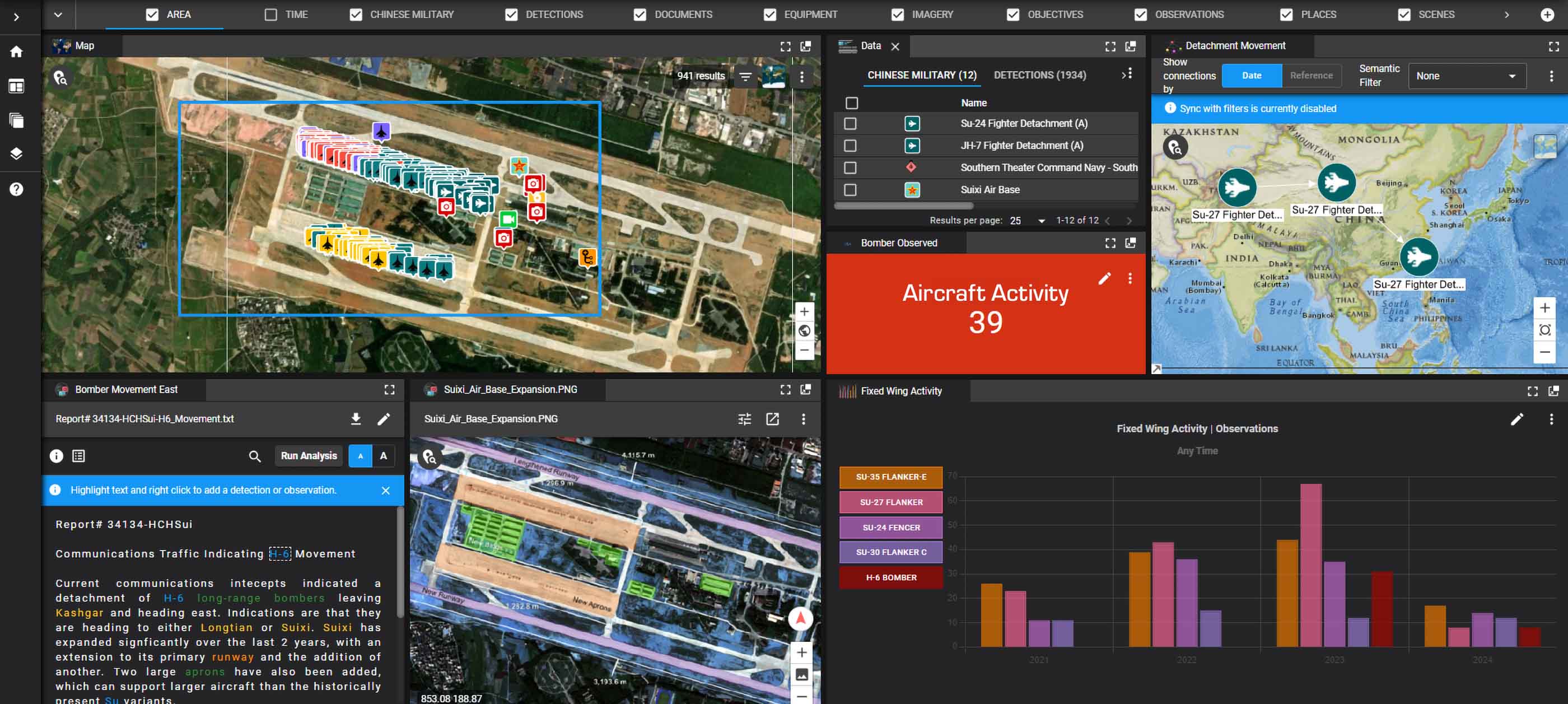GXP Fusion® v2.6
Integrate information from multiple sources to answer complex intelligence questions
Request additional info or a product demo
Interactive GXP Fusion® UI
Data Analytics
Identify and illustrate data trends, patterns, and anomalies through a variety of charts and graphs.
Image Viewer
Visualize areas and objects of interest collected through both SOCET GXP and GXP WebView applications.
Map Viewer
Discover geotagged data by location using the 3-D Globe and Data Feed List.
Network Graph: Observation
Identify activities associated with people, places and things.
Network Graph: Equipment
Identify types of equipment and their association with people and places.
Network Graph: Country
The focus in this scenario is a specific country with associated people and locations, types of weaponry, and other observations.
Network Graph: Location
Identify specific locations and associated links to that location.
Text Analytics
Natural Language Processing (NLP) via Babel Street Analytics provides fast and effective text review and indexing to identify persons, organizations, locations, and more based on a customizable lexicon.
Timeline
Develop a comprehensive and chronologically organized timeline based on activities, locations, and imagery.
Data Analytics
Image Viewer
Map Viewer
Text Analytics
North Korea launched a series of short-range missiles in March, marking its first missile tests in 2020 and signaling Pyongyang's intent to follow through with Kim Jong Un…'s promise to possess a "new strategic weapons" in the near future. Kim announced North Korea would continue to develop "necessary and prerequisite strategic weapons" throught the year in his speech at a plenary meeting of the… 7th Central Committee of the Worker's Party of Korea, held Dec. 28-31.
Images released by Pyongyang's Korea Central TV confirm that the two short-range ballistic missiles launched on March 21 had similar features to the KN-24 missile last tested in August 2019. Kim oversaw the recent test, according to a March 22 statement in the state-run Korean Central News Agency (KCNA)
The statement said that the tested missile will “be delivered to [Korean Peoples’ Army] units,” which analysts have speculated may indicate the missile could soon be operational. In a statement a day earlier, KCNA reported the launches were part of an “artillery fire competition between large combined units of the Korean People’s Army.”
The launch came after weeks of successive short-range ballistic missile tests by North Korea following a Feb. 29 KCNA announcement that Kim had overseen a military drill intended to “judge the mobility and the fire power strike ability” of North Korea’s Korean People’s Army’s defense units.
All the March tests appear to have been of short-range ballistic missiles, meaning they can fly less than 500 kilometers. Two missiles launched on March 2 bore some similarity to previous flight tests of North Korea’s KN-25 short-range ballistic missile, according to Michael Elleman, a missile expert at the International Institute for Strategic Studies (IISS). A statement released on March 2 by South Korea’s Joint Chiefs of Staff (JCS) via the Yonhap News Agency further identified “similarities in features between what it fired [March 2] and those launched last year.”
North Korea also tested three projectiles on March 9, all of which were KN-25 missiles, according to recently released IISS assessments.
“North Korea is believed to be continuing its joint strike drill,” said a senior South Korean JCS officer. Kim oversaw the March 9 launches and expressed “great satisfaction” and “highly appreciated the perfect combat readiness of the long-range artillery sub-units,” the KCNA reported the following day.
Those tests came one day after the North Korean Foreign Ministry responded through the KCNA to a joint statement released by five UN Security Council members condemning the March 2 launches. “The reckless behavior of these countries instigated by the U.S. will become the fuse that will trigger yet another momentous reaction,” the Foreign Ministry said.
After a March 5 meeting of the Security Council, Belgium, Estonia, France, Germany, and the United Kingdom urged North Korea to “engage in good faith in meaningful negotiations with the United States aimed at denuclearization” and to abandon “all weapons of mass destruction and ballistic missile programs in a complete, verifiable, and irreversible manner.”
South Korea’s presidential office said on March 9 that “North Korea continuing to stage joint massive artillery drills following those on Feb. 28 and March 2 does not help efforts to bring peace to the Korean peninsula.”
Despite allies’ mention of meaningful negotiations between the United States and North Korea, discussions on denuclearization and peacebuilding appear to remain stalled. (See ACT, March 2020).
Timeline
Network Graph
GXP Fusion Capabilities
Faced with a significantly increasing volume of information to discover and analyze, GXP® solutions enable analysts to fuse disparate sources into a multi-perspective view, allowing for delivery of insightful intelligence and enhanced situational awareness to key decision makers. Developed to support a seamless connection to current and future intelligence, GXP Fusion software functions as the central point for maximizing an organization’s intelligence capabilities.

Built on the GXP Xplorer® Platform, the GXP Fusion software solution enables users to:
- Create activity-based automatic alerts on multi-source data to prioritize analysis
- Develop a dashboard to increase operational awareness
- Associate all spatio-temporal information in a single view through a browser-based, multi-source visualization tool
- Connect to third-party systems and data sources via plug-ins
- Provide data collection, consolidation, and discovery of multi-source information including open and closed source data
- Spend less time sifting through data and more time analyzing data
- Improve user workflow through automation based on a rule-based process engine, such as a watchbox and a trigger
- Correlate various types of data to find and visualize related information
- Integrate seamlessly with Structured Observation Management (SOM) workflows
Find hidden patterns and relationships in multi-source data
GXP Fusion software is designed for Department of Defense, Intelligence Community, and Law Enforcement personnel with big data challenges who want to gain insights via identification of hidden relationships and patterns in large volumes of data. GXP Fusion software empowers the analyst to make smarter decisions by tailoring their workflows and leveraging third-party Artificial Intelligence (AI) / Machine Learning (ML) technology while enjoying a seamless user experience:
- Identify hidden patterns using interactive Data Analytics Charts
- Find time phased activities using the Data Timeline Chart
- View geotagged and non-geotagged data using the 3-D Globe and Data Feed List
- Analyze additional observations collected from SOCET GXP® and GXP WebView® applications
- Visualize complex relationships and patterns using the Network Graph
Unlock knowledge by fusing data based on location, time, and data attributes
The GXP Fusion DVR-like controls can isolate time range and provide a playback mode for forensic analysis, while intelligent filters can further isolate additional information as required. In addition, linked panels communicate in real time, and an extensible Widgets Gallery enables third-party customization.
GXP® Ecosystem
Providing the foundation for development of the most advanced geospatial intelligence, the GXP Ecosystem delivers an unrivaled capacity for discovery, exploitation, and dissemination of mission‑critical geospatial and temporal data.
